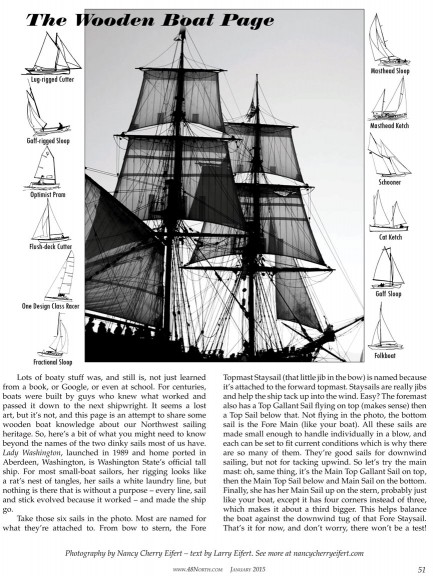Click on the image – it gets a lot bigger.
I’m now teaming up with Nancy and her photography for a new 48 North magazine story page. This is the Seattle sailing magazine I write for with my own work, but now we’ve turned it into a bit of a game with her fine photography and a second page. She tosses me a photo, I make up the rest – weave a tale about wooden boats, their history, legacy and how they work. For those who know, I have a very long history of sailing old wooden boats – built one when I was 12, sailed to Alaska and later Mexico, pounded more caulk and spread more varnish than I care to think about.
This is the first issue for January 2015. And here’s the text:
Lots of boaty stuff was, and still is, not just learned from a book, or Google, or even at school. For centuries, boats were built by guys who knew what worked and passed it down to the next shipwright. It seems a lost art, but it’s not, and this page is an attempt to toss out some wooden boat knowledge about our Northwest sailing heritage. So, here’s a bit of what you might need to know beyond the names of the two dinky sails most of us have. Lady Washington, launched in 1989 and home ported in Aberdeen, Washington, is Washington State’s official tall ship. For most small-boat sailors, her rigging looks like a rat’s nest of tangles, her sails a white laundry line, but nothing is there that is without a purpose – every line, sail and stick evolved because it worked – and made the ship go.
Take those six sails in the photo. Most are named for what they’re attached to. From bow to stern, the Fore Topmast Staysail (that little jib in the bow) is named because it’s attached to the forward topmast. Staysails are really jibs and help the ship tack up into the wind. Easy? The foremast also has a Top Gallant Sail flying on top (makes sense) then a Top Sail below that. Not flying in the photo, the bottom sail is the Fore Main (like your boat). All these sails are made small enough to handle individually in a blow, and each can be set to fit current conditions which is why there are so many of them. They’re good sails for downwind sailing, but not for tacking upwind. So let’s try the main mast: oh, same thing, it’s the Main Top Gallant Sail on top, then the Main Top Sail below and Main Sail on the bottom. Finally, she has her Main Sail up on the stern, probably just like your boat, except it has four corners instead of three – which makes it about a third bigger. This helps balance the boat against the downwind tug of that Fore Staysail. That’s it for now, and don’t worry, there won’t be a test!
Photography by Nancy Cherry Eifert – text by Larry Eifert. See more at nancycherryeifert.com
Larry Eifert
Thanks for reading this week. Send this to someone who might appreciate what I’m painting and tell them to sign up. I’m trying to expand my list. An email will work.
Here’s the blog on the web.And here’s my Facebook fan page. I post lots of other stuff there.
Click here to go to our main website – with jigsaw puzzles, prints, interpretive portfolios and lots of other stuff.
Nancy’s web portfolio of beautiful photographs
And Click here to go to Virginia Eifert’s website. Her books are now becoming available as Amazon Kindle books.

